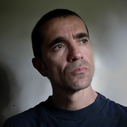
FESTIVAL/TOKYO
Performing Arts Festival launching from Tokyo

F/T regulars Romeo Castellucci and Norimizu Ameya open the 2011 Festival with a double bill. The new works are inspired by texts by Japanese poet Kenji Miyazawa, with an audience of 1,000 able to experience both outdoor performances.
Double stagings from Ameya and Castellucci
Norimizu Ameya with his radical productions of "Transfer Student", "4.48 Psychosis" and "The shape of me" has given the Japanese theatre scene a fresh impetus. Romeo Castellucci left a deep impact on Japanese audiences with the extraordinary visual energy of his pieces "Hey Girl" and "The Divine Comedy" (F/T09 Spring and F/T09 Autumn).
By bringing together these two artists of the same generation F/T will open up new creativity inside a single unified space, time and shared audience experience.
Dual mental landscapes mediated through Kenji Miyazawa
For this commission F/T set two terms: to create a theatrical work freely inspired by a text of Kenji Miyazawa; and to stage the works at any location apart from a theatre building.
For Romeo Castellucci, this was his first encounter with the Japanese poet Kenji Miyazawa. After reading a number of Italian translations of Miyazawa's tales and poems, Castellucci finally decided on the preface to the book of poems "Spring and Asura". The title of his contribution "The Phenomenon called I" is the beginning of the very first verse of that same book. Ameya, on the other hand, has been familiar with Miyazawa's literature since his childhood will access Miyazawa's literary world again, extracting from it a reflection on the material and human life.
In his literature Miyazawa intermingles humans, animals and plants, as phenomena of nature like clouds, stars and the wind as well as orbs such as the earth, the sun and the stars appear equally. By this, he not only pictures the
struggles of his personal life and the contradictions of human existence, but also lets a dialogue emerge involving
all elements of nature and space. 80 years after Miyazawa's death, how will the author's world view reappear as
seen through the eyes of Castellucci and Ameya - and be reflected in the mental landscape of today?
The location of the performance Yumenoshima was chosen by Norimizu Ameya after the 3.11 earthquake and
tsunami. Yumenoshima is a manmade land that was reclaimed to dispose of the huge amount of waste during the
period of enormous economic growth after World War II. This waste dump, currently fully in use, utilizes the energy
from the waste incineration to supply a nearby botanical garden and a sport center with electrical power.
The performances will take place at the Multipurpose Colosseum on Yumenoshima, a huge round space of 120 metres in diameter; the spectators will sit all around the space at angles of 360 degrees. In the midst of the beauty of an artificial nature, what kind of illusion with Castellucci and Ameya conjure up? Miyazawa's words, the trees, the wind, the sky, the stars and the physical presence of the 1,000 spectators will resound together in the contradictory magnetism of Yumenoshima.
Born in 1896 in Hamaki City (Iwate prefecture).
In 1924 he published his collection "Spring and Asura" and his children's story collection, "The Restaurant of Many Orders". Other main works include: "Night on the Galactic Railroad" (1934), "Ame ni mo Makezu" (1931) and "Kaze no Matasaburo" (1934). He campaigned for improved rural lifestyles but died of pneumonia in 1933, at the age of 37.


